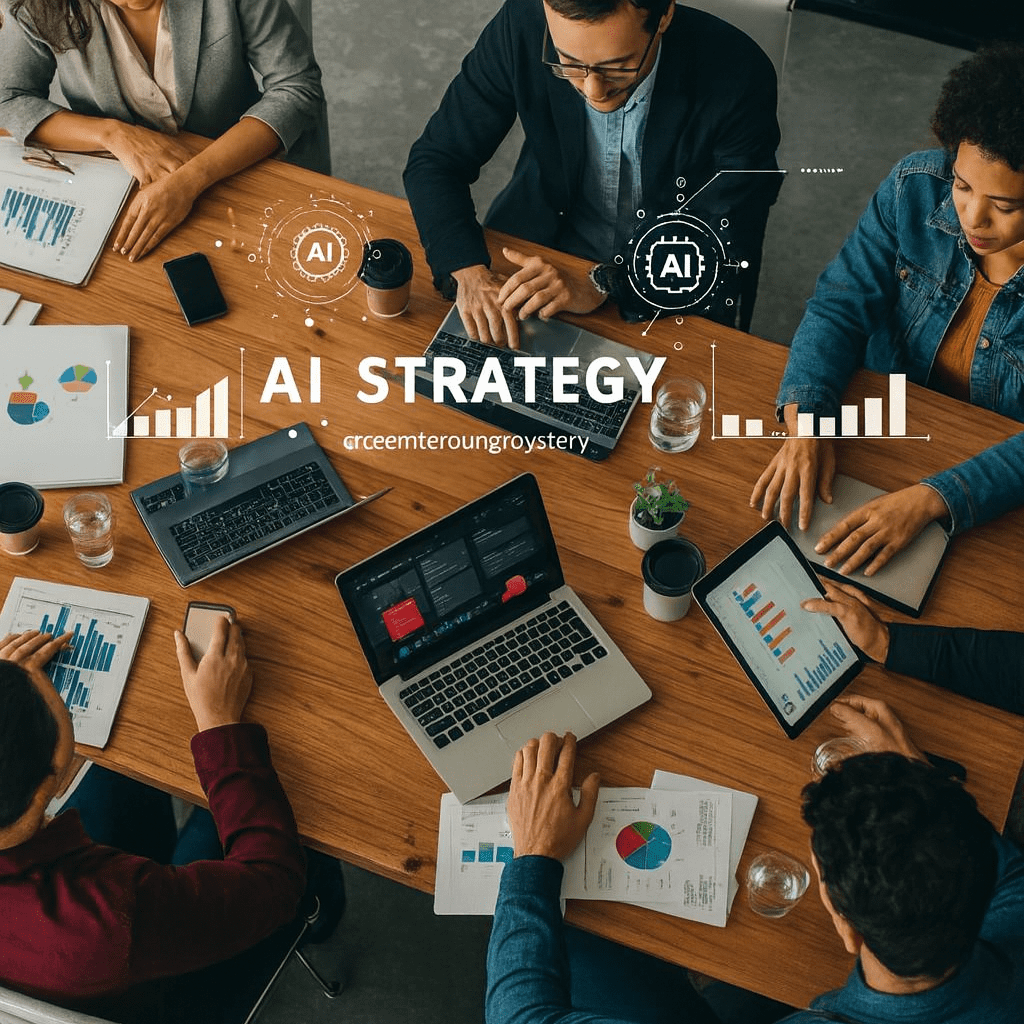Knowledge of AI: A Necessity for Businesses to Stay Competitive
Effective AI strategy for businesses combines clear vision, robust data foundations, strategic roadmaps, and responsible governance to improve operational performance while maintaining organizational balance. As of October 2025, 78 percent of companies leverage AI in at least one function, yet many struggle to align innovation with sustainable growth. This guide delivers a step-by-step map: defining core AI strategy principles, exploring leadership services, surveying practical AI solutions, outlining an implementation roadmap, balancing innovation and risk, surveying 2025 trends, and building authority in AI solutions and leadership. Business leaders will gain actionable frameworks to boost efficiency, preserve balance, and engage AI Leadership Services and AI Solutions as catalysts for measurable growth.
What Is an Effective AI Strategy for Business Growth?
An effective AI strategy for business growth is a structured plan that aligns artificial intelligence initiatives with organizational objectives, establishes a data-driven culture, and embeds governance to ensure sustainable outcomes. By integrating vision, datainfrastructure, execution frameworks, and change management, companies unlock efficiency improvements while preserving human oversight. Such a strategy empowers decision-makers to harness machine learning, natural language processing, and generative AI capabilities in ways that drive competitive advantage and balanced expansion.
How Does AI Strategy Enhance Business Efficiency and Balance?
An AI strategy enhances businessefficiency by automating repetitive tasks, optimizing workflows, and providing real-time insights, while balancing innovation and risk through governance and human-in-the-loop safeguards. For example, predictive maintenance algorithms can reduce downtime and resource waste, yet oversight mechanisms ensure ethical data use and workforce adaptability. This dual focus on automation gains and responsible deployment preserves corporate values and employee engagement, linking efficiency improvements to long-term stability.
What Are the Key Components of a Successful AI Strategy?
A successful AI strategy comprises aligned business objectives, robust data management, scalable infrastructure, defined governance, and clear performance metrics.
Before examining these in detail, the following table breaks down each essential component.
| Component | Description | Business Impact |
|---|---|---|
| Strategic Alignment | Vision and objectives that mirror corporate priorities | Ensures AI projects deliver strategic value |
| Data Foundation | Data quality, integration, and governance processes | Enables accurate models and reliable insights |
| Technical Infrastructure | Scalable platforms, cloud services, and analytics tools | Supports rapid development and deployment |
| Governance & Ethics | Policies, oversight, and risk management frameworks | Maintains trust, compliance, and balance |
| Performance Metrics | KPIs for model accuracy, ROI, and efficiency gains | Tracks progress and guides continuous improvement |
Each component underpins the next, creating a cohesive framework that drives measurable efficiency gains and balanced growth.
How Do AI Strategy Frameworks Support Enterprise Transformation?
AI strategy frameworks offer structured approaches—such as iterative pilots, agile development sprints, and stage-gate reviews—that guide enterprises from proof-of-concept to scaled deployment. These frameworks unify stakeholders around shared milestones, define resource requirements, and embed feedback loops to refine models continuously. By adopting an enterprise transformation roadmap, organizations transition smoothly from experimentation to operational integration, ensuring AI initiatives deliver ongoing value.
Why Is Assessing AI Readiness Critical for Implementation?
Assessing AI readiness evaluates organizational maturity across culture, skills, data assets, and technologyinfrastructure, revealing gaps that could derail deployments. Readiness assessments typically score data quality, executive sponsorship, workforce capabilities, and governance practices. Identifying deficiencies early enables targeted investments in training, data cleansing, and platform upgrades—preventing costly rework and accelerating time to value.
How Can AI Leadership Services Empower Business Executives?
AI Leadership Services equip executives with strategic guidance, ethical frameworks, and practical methodologies to champion AI-driven transformations. These services foster a leadershipculture that understands AI’s potential and limitations, aligns teams around common goals, and navigates complex change management. By partnering with specialized consultants, C-suite leaders gain clarity on AI opportunities, risk mitigation, and organizational balance.
What Roles Do AI Leaders Play in Driving Digital Transformation?
AI leaders act as visionaries, translating business objectives into AI use cases, coordinating cross-functional teams, and securing executive buy-in for investments. They oversee datastrategy, champion ethical AI deployment, and measure impact against strategic KPIs. Through this multifaceted role, AI leaders ensure digital transformation initiatives remain aligned with corporate values and deliver sustainable efficiency gains.
How to Build Ethical AI Frameworks for Responsible AI Governance?
Effective ethical AI frameworks establish guiding principles, compliance checkpoints, and accountability structures to mitigate bias and protect stakeholder interests. The following list outlines core practices for responsible governance:
- Define clear ethical principles that reflect organizational values.
- Implement bias-detection tools to audit models at each development stage.
- Establish cross-functional ethics committees for oversight and escalation.
- Document data lineage and privacy safeguards in all AI workflows.
- Integrate continuous monitoring protocols to detect emerging risks.
These best practices embed trust and transparency into AI deployments, preparing organizations for regulatory scrutiny and market expectations.
What Are Best Practices for Upskilling Teams in AI Leadership?
Developing AI leadership capabilities requires a blend of formal training, hands-on workshops, and mentorship programs. Structured curricula should cover data literacy, model interpretation, ethical considerations, and change management. Pairing executive coaching with project-based learning accelerates skill adoption and cultivates a culture of innovation. Continuous learning pathways reinforce the ability to steer AI initiatives and adapt to evolving technologies.
How Can Leaders Manage Organizational Change with AI?
Leaders manage organizational change by articulating a compelling AI vision, mapping stakeholder journeys, and deploying pilot programs that demonstrate quick wins. Change management plans include communication strategies, role-based training, and mechanisms for employee feedback. By sustaining open dialogue and celebrating milestones, executives foster trust and minimize resistance, ensuring AI initiatives embed seamlessly into corporate processes.
What Are the Practical AI Solutions That Boost Business Efficiency?
Practical AI solutions focus on automation, predictive insights, and advanced analytics to optimize core operations. Companies deploy process–automation bots to handle repetitive tasks, predictive analytics to forecast demand, and generative AI to personalize customer interactions. These targeted solutions translate technical capabilities into tangible efficiency gains and enhanced customer experiences.
How Does AI Improve Operational Efficiency Across Industries?
AI improves operational efficiency through intelligent automation of routine tasks, real-time anomaly detection, and dynamic resource allocation. Manufacturing firms use machine-vision inspection to reduce defects, logistics providers apply route-optimization algorithms to cut fuel consumption, and financial services leverage automated underwriting to accelerate loan approvals. Across sectors, AI solutions streamline workflows, decrease error rates, and free human capital for higher-value activities.
What Role Does Predictive Analytics Play in Strategic Decision-Making?
Predictive analytics mines historical and real-time data to forecast trends, customer behavior, and risk scenarios, supporting proactive decision-making. Sales teams use demand-forecast models to optimize inventory, while finance leaders apply scenario simulations to manage cash flow. By embedding predictive insights into dashboards and workflows, organizations shift from reactive management to strategic foresight.
How Are Generative AI Applications Transforming Customer Experience?
Generative AI transforms customerexperience by creating personalized content, automating natural language interactions, and accelerating product design. Customer service chatbots generate context-aware responses, marketing platforms craft tailored promotional messages, and design tools prototype new offerings based on textual prompts. These capabilities boost engagement, reduce response times, and foster deeper brand relationships.
How Can AI Optimize Supply Chain and Resource Management?
AI optimizes supply chainmanagement by forecasting demand, balancing inventory levels, and orchestrating multi-tier logistics. Reinforcement-learning algorithms adjust reorder points dynamically, while digital twins simulate supply-chain scenarios to identify bottlenecks. This data-driven approach reduces stockouts, minimizes holding costs, and increases resilience against disruptions.
What Is the AI Implementation Roadmap for Enterprise Success?
An AI implementation roadmap guides organizations through vision setting, pilot execution, scaling, and continuous improvement to achieve sustainable impact. This phased approach aligns cross-functional teams, allocates resources efficiently, and embeds governance at each stage. A clear roadmap accelerates adoption, reduces risk, and ensures measurable ROI.
What Are the Key Stages in Developing an AI Strategy Roadmap?
Developing an AI strategy roadmap involves four key stages:
- Vision & Alignment – Define strategic objectives and secure leadership sponsorship.
- Pilot & Validation – Conduct small-scale proof-of-concepts to test feasibility and refine models.
- Scale & Integration – Expand successful pilots into core systems and processes with robust infrastructure.
- Govern & Optimize – Implement governance frameworks, monitor performance, and iterate for continuous improvement.
These stages create a structured journey from concept to enterprise-wide adoption, balancing speed and control.
How Can Businesses Mitigate Risks During AI Deployment?
Risk mitigation during AI deployment centers on datagovernance, model validation, and ethical oversight. Organizations establish risk registers, conduct bias audits, and embed rollback procedures in production pipelines. Cross-functional risk committees review model outputs and enforce compliance checks, ensuring deployments adhere to legal and ethical standards without stalling innovation.
What Strategies Help Scale AI Initiatives Across the Organization?
Scaling AI requires platform standardization, reusable model repositories, and centralized governance to promote consistency. The following strategies facilitate enterprise-level expansion:
- Foster internal AI centers of excellence to share best practices.
- Develop modular AI components for rapid integration into diverse applications.
- Allocate dedicated budgets for continuous model training and infrastructure maintenance.
- Align performance incentives with AI adoption milestones.
By institutionalizing these strategies, organizations multiply efficiency gains and sustain balanced growth.
How to Measure ROI and Success Metrics for AI Investments?
Measuring ROI on AI investments involves tracking financial and operational KPIs—such as cost savings, revenue uplift, error reduction, and time-to-market improvements. Dashboards integrate model performance metrics (accuracy, latency) with business indicators (revenue growth, customer satisfaction). Regular reviews tie AI outcomes to strategic goals, guiding reinvestment decisions and validating the value of AI Leadership Services and AI Solutions.
How Does Balancing Innovation and Risk Enhance AI Strategy Outcomes?
Balancing innovation and risk ensures AI initiatives deliver breakthrough results without exposing organizations to unchecked liabilities. By coupling exploratory pilots with rigorous governance, companies harness creative potential while safeguarding data privacy, ethical standards, and operational continuity. This equilibrium drives sustainable efficiency gains and fosters long-term trust.
What Are the Challenges of Balancing Automation with Human Oversight?
Balancing automation with human oversight requires clear delineation of decision boundaries, robust monitoring systems, and upskilling to ensure employees can interpret AI outputs. Over-automation risks bypassing critical judgment, while excessive manual controls hinder efficiency. Striking the right balance empowers teams to leverage AI speed without compromising accountability or skill development.
How to Align Short-Term Efficiency Gains with Long-Term Sustainability?
Aligning short-term efficiency gains with long-term sustainability demands integrated planning that incorporates environmental, social, and governance (ESG) criteria into AI objectives. Organizations set dual KPIs—immediate cost reductions and multi-year impact on workforce skills, data ethics, and carbon footprint. This holistic approach preserves enterprise balance while realizing rapid performance improvements.
What Ethical Considerations Ensure Responsible AI Adoption?
Responsible AI adoption hinges on transparency, fairness, accountability, and privacy protections. Practical steps include open-model documentation, stakeholder communication plans, standardized bias-detection processes, and secure data pipelines. Embedding these considerations throughout the AI lifecycle maintains stakeholder trust and aligns deployments with corporate values.
What Are the Latest Trends Shaping AI Strategy for Businesses in 2025 and Beyond?
Innovations in multimodal AI, AI agents, assistive search, and decision intelligence define the frontier of AI strategy in 2025. Organizations that anticipate these shifts and integrate emerging capabilities into roadmaps will outpace competitors and sustain balanced growth.
How Are Multimodal AI and AI Agents Impacting Business Models?
Multimodal AI—combining text, vision, and audio—and autonomous AI agents are transforming workflows by enabling richer human-machine interactions and automated decision loops. Retailers deploy AI agents to manage inventory replenishment autonomously, while marketing teams use multimodal models to analyze customer sentiment across images and text. These advances redefine business models through continuous, context-aware automation.
What Is the Role of Assistive Search and AI-Powered Customer Experience?
Assistive search leverages AI-driven semantic understanding to deliver contextually relevant results across knowledge bases, improving internal productivity and self-service portals. Customerexperience platforms integrate AI recommendations to guide users through complex product catalogs, enhancing satisfaction and conversion rates. This trend underscores the strategic value of natural-language interfaces and personalized engagement.
How Does Decision Intelligence Leverage Predictive Analytics?
Decision intelligence marries predictive analytics with prescriptive modeling and business rules to suggest optimal actions for strategic challenges. Finance teams use decision-intelligence systems to balance risk and return in portfolio management, and supply chain managers adopt these tools to adjust sourcing strategies dynamically. By embedding real-time analytics into decision workflows, organizations elevate strategic agility.
How Can Businesses Establish Authority in AI Solutions and Leadership?
Building authority in AI solutions and leadership involves showcasing real-world successes, quantifying impact, and demonstrating SEO mastery to signal expertise. Thought leadership content, case studies, and structured data implementations reinforce domain authority, while AI Leadership Services guide executives to articulate the organization’s unique value.
What Case Studies Demonstrate Successful AI Strategy Implementation?
Recent examples illustrate how enterprises achieved efficiency and balanced growth through tailored AI strategies. A global retailer reduced inventory costs by 18 percent using predictive demand models, and a healthcare provider improved patient triage accuracy by 25 percent with NLP–powered symptom analysis. These cases underscore the value of integrated AI Solutions and governance frameworks.
How Do AI Leadership Services Drive Competitive Advantage?
AI Leadership Services differentiate through strategic roadmapping, executive coaching, and ethical governance that ensure efficient, balanced deployments. By fostering an AI-savvy leadershipculture, these services accelerate decision cycles, mitigate risks, and elevate innovation capacity. Organizations partnering with expert advisors consistently report higher ROI and sustained market leadership.
What Metrics Prove the ROI of AI Solutions for Business Efficiency?
Key metrics include cost savings per employee hour, percentage reduction in error rates, revenue growth attributable to AI-driven upselling, and time-to-market improvements. Companies report a 3.7× ROI for every dollar invested in generative AI solutions and an average of 2.5 saved hours per employee per day. These performance indicators validate the strategic importance of AI Solutions.
How to Use Structured Data and Semantic SEO to Enhance AI Thought Leadership?
Implementing , , and schema, along with and markup for guides, boosts visibility in rich results and knowledge panels. Incorporate entity annotations for “AI Strategy,” “AI Leadership Services,” and “Generative AI” to strengthen knowledge graph connections. This SEO strategy amplifies authority signals and drives qualified leads to AI leadership offerings.
Organizations that integrate these semantic SEO practices position themselves as trusted experts in AI solutions and leadership, unlocking new client engagements and market recognition.
Leading companies that adopt a comprehensive AI strategy—backed by AI Leadership Services and AI Solutions—achieve both efficiency gains and sustainable balance. By aligning vision, data, governance, and execution frameworks, organizations unlock measurable ROI and foster enduring trust. Continuous investment in ethical governance and emerging trends such as multimodal AI will sustain competitive advantage into 2026 and beyond. Embrace this structured approach to transform AI potential into lasting leadership.
Frequently Asked Questions
What are the common pitfalls businesses face when implementing AI strategies?
Common pitfalls in AI strategy implementation include lack of clear objectives, insufficient data quality, and inadequate change management. Many organizations fail to align AI initiatives with business goals, leading to wasted resources. Additionally, poor datagovernance can result in unreliable models, while neglecting employee training can create resistance to new technologies. To avoid these issues, businesses should conduct thorough readiness assessments, establish clear communication channels, and ensure ongoing support for teams throughout the implementation process.
How can businesses ensure ethical AI practices during deployment?
To ensure ethical AI practices, businesses should establish a comprehensive framework that includes transparency, accountability, and fairness. This involves defining ethical guidelines, conducting regular bias audits, and creating cross-functional ethics committees to oversee AI projects. Additionally, organizations should document data usage and model decisions to maintain accountability. Continuous monitoring and stakeholder engagement are crucial to adapt to emerging ethical challenges and maintain trust in AI systems.
What role does employee training play in successful AI adoption?
Employee training is vital for successful AI adoption as it equips staff with the necessary skills to leverage AI tools effectively. Training programs should focus on data literacy, model interpretation, and ethical considerations. By fostering a culture of continuous learning, organizations can enhance employee confidence and engagement with AI technologies. This investment not only improves operational efficiency but also helps in overcoming resistance to change, ensuring smoother integration of AI into business processes.
How can organizations measure the success of their AI initiatives?
Organizations can measure the success of their AI initiatives through a combination of quantitative and qualitative metrics. Key performance indicators (KPIs) may include cost savings, revenue growth, customer satisfaction scores, and operational efficiency improvements. Additionally, tracking model performance metrics such as accuracy and latency can provide insights into the effectiveness of AI solutions. Regular reviews and feedback loops help organizations assess progress and make necessary adjustments to align AI outcomes with strategic goals.
What are the emerging trends in AI that businesses should watch for?
Emerging trends in AI that businesses should monitor include advancements in multimodal AI, which integrates various data types for richer insights, and the rise of AI agents that automate complex tasks. Additionally, decision intelligence is gaining traction, combining predictive analytics with prescriptive modeling to enhance strategic decision-making. Organizations that stay ahead of these trends can leverage new capabilities to improve efficiency, customerexperience, and competitive advantage in their respective markets.
How can businesses balance innovation with risk management in AI projects?
Balancing innovation with riskmanagement in AI projects involves establishing a robust governance framework that includes risk assessment protocols and ethical guidelines. Organizations should adopt a phased approach to AI deployment, starting with pilot programs to test concepts before scaling. Continuous monitoring and feedback mechanisms are essential to identify potential risks early. By fostering a culture of responsible innovation, businesses can explore new opportunities while safeguarding against potential liabilities and ethical concerns.
Conclusion
Leading companies that adopt a comprehensive AI strategy—backed by AI Leadership Services and AI Solutions—achieve both efficiency gains and sustainable balance. By aligning vision, data, governance, and execution frameworks, organizations unlock measurable ROI and foster enduring trust. Continuous investment in ethical governance and emerging trends such as multimodal AI will sustain competitive advantage into 2026 and beyond. Embrace this structured approach to transform AI potential into lasting leadership.






